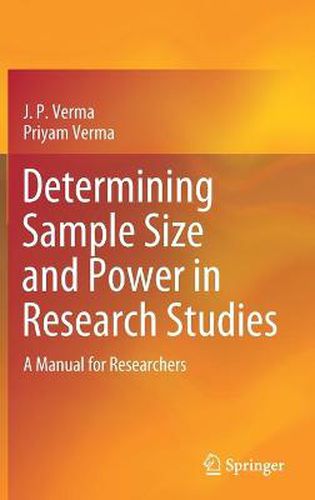Readings Newsletter
Become a Readings Member to make your shopping experience even easier.
Sign in or sign up for free!
You’re not far away from qualifying for FREE standard shipping within Australia
You’ve qualified for FREE standard shipping within Australia
The cart is loading…






This title is printed to order. This book may have been self-published. If so, we cannot guarantee the quality of the content. In the main most books will have gone through the editing process however some may not. We therefore suggest that you be aware of this before ordering this book. If in doubt check either the author or publisher’s details as we are unable to accept any returns unless they are faulty. Please contact us if you have any questions.
This book addresses sample size and power in the context of research, offering valuable insights for graduate and doctoral students as well as researchers in any discipline where data is generated to investigate research questions. It explains how to enhance the authenticity of research by estimating the sample size and reporting the power of the tests used. Further, it discusses the issue of sample size determination in survey studies as well as in hypothesis testing experiments so that readers can grasp the concept of statistical errors, minimum detectable difference, effect size, one-tail and two-tail tests and the power of the test. The book also highlights the importance of fixing these boundary conditions in enhancing the authenticity of research findings and improving the chances of research papers being accepted by respected journals.
Further, it explores the significance of sample size by showing the power achieved in selected doctoral studies. Procedure has been discussed to fix power in the hypothesis testing experiment. One should usually have power at least 0.8 in the study because having power less than this will have the issue of practical significance of findings. If the power in any study is less than 0.5 then it would be better to test the hypothesis by tossing a coin instead of organizing the experiment. It also discusses determining sample size and power using the freeware G*Power software, based on twenty-one examples using different analyses, like t-test, parametric and non-parametric correlations, multivariate regression, logistic regression, independent and repeated measures ANOVA, mixed design, MANOVA and chi-square.
$9.00 standard shipping within Australia
FREE standard shipping within Australia for orders over $100.00
Express & International shipping calculated at checkout
This title is printed to order. This book may have been self-published. If so, we cannot guarantee the quality of the content. In the main most books will have gone through the editing process however some may not. We therefore suggest that you be aware of this before ordering this book. If in doubt check either the author or publisher’s details as we are unable to accept any returns unless they are faulty. Please contact us if you have any questions.
This book addresses sample size and power in the context of research, offering valuable insights for graduate and doctoral students as well as researchers in any discipline where data is generated to investigate research questions. It explains how to enhance the authenticity of research by estimating the sample size and reporting the power of the tests used. Further, it discusses the issue of sample size determination in survey studies as well as in hypothesis testing experiments so that readers can grasp the concept of statistical errors, minimum detectable difference, effect size, one-tail and two-tail tests and the power of the test. The book also highlights the importance of fixing these boundary conditions in enhancing the authenticity of research findings and improving the chances of research papers being accepted by respected journals.
Further, it explores the significance of sample size by showing the power achieved in selected doctoral studies. Procedure has been discussed to fix power in the hypothesis testing experiment. One should usually have power at least 0.8 in the study because having power less than this will have the issue of practical significance of findings. If the power in any study is less than 0.5 then it would be better to test the hypothesis by tossing a coin instead of organizing the experiment. It also discusses determining sample size and power using the freeware G*Power software, based on twenty-one examples using different analyses, like t-test, parametric and non-parametric correlations, multivariate regression, logistic regression, independent and repeated measures ANOVA, mixed design, MANOVA and chi-square.